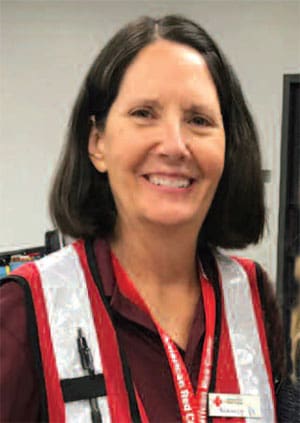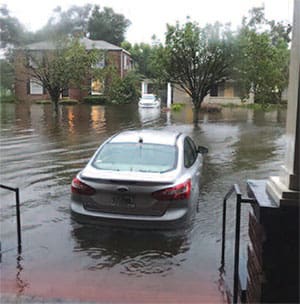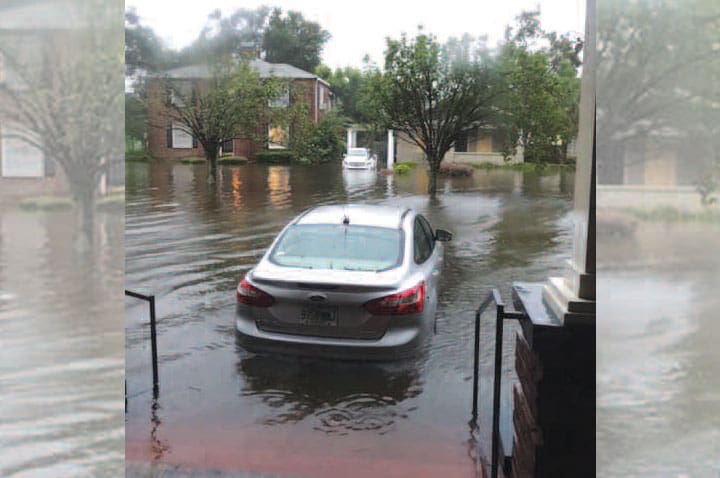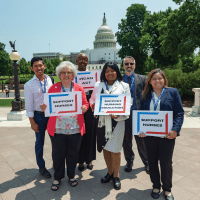AMERICAN NURSE TODAY asked nurses to share their personal and professional experiences related to Hurricanes Harvey and Irma. Here are a few of their responses.
Fulfilling a professional responsibility
Bree Walker, RN, BSN
Wolfson Children’s Hospital
Jacksonville, FL
Hurricanes “never” hit Jacksonville directly; the current always sweeps them to the north. Unfortunately, this was not the case with Hurricane Irma.
For the past 2 years, I’ve served on the local children’s hospital planned emergency response team. At 8 am on September 11, 2017, while I was at work, I received a text message from my boyfriend
informing me that the first floor apartment we called home was taking on water. Our apartment, like the hospital, is along the St. Johns River. I felt helpless as I watched river water rise, breaching its banks and heading into town; I could see everything from the hospital windows. An announcement was made for employees to move their cars to higher ground, and that the neonatal intensive care unit and pharmacy was being relocated.
How could I continue to focus on work, while the future was so uncertain? I had a responsibility to my patients, that’s how. Fighting back tears, I continued to serve my patients to the best of my ability—singing songs while giving medications, awarding prizes for being brave during procedures, and calming fears.
My car was a total loss, along with our apartment and all of our furniture, but “things” can be replaced. In such a trying time, my faith in humanity has been restored. Several Good Samaritans worked with local law enforcement to rescue trapped residents, including my boyfriend and our cats. Friends and family (especially my work family!) have been by our side every step of the way, showing so much love and support. In a time that most would consider pure chaos, we feel so very fortunate. I chose to dedicate my life to the health and safety of others. Even on difficult days, in the most challenging situations, I love what I do and wouldn’t have it any other way. I’m proud to be a pediatric nurse.
First volunteer experience
Nancy K. Van Etten, MN, CCM, RN
American Red Cross Volunteer

I volunteered for a 2-week deployment in Texas, my first experience as an American Red Cross Volunteer. Here’s what I learned:
- The Red Cross is very quick to deploy you once you agree to be deployed. I was on an airplane to Austin, Texas within 12 hours. Expenses, including travel, food, and lodging, are paid (although there’s a limit).
- You’ll have plenty of mentors to learn from. Many volunteers have been deployed numerous times to various disasters and are quick to teach you the pros and the cons and what to expect.
- Because situations on the ground are very fluid, you have to be flexible and willing to wait up to 1 to 2 days before you know what you’ll be doing. I had planned to be a shelter assistant, but they needed more registered nurses so I quickly got my paperwork completed and received just-in-time training to be assigned a staff wellness job. I was paired up with an LPN, and we drove a rental car from Austin to San Antonio.
- Different states have different structures for how they manage disasters. My cohort LPN and I did well collaborating and communicating with the various entities at the shelters, which benefited the evacuees (clients) and entity staff.
- The shelter is a community of young and old, ncluding those with chronic and acute illness, mental health concerns, and socioeconomic ssues. On top of this are added stressors of losses of loved ones, personal health, home, job, possessions, animals, and cell phones.
One young man’s caregiver and two roommates had died. He had mental health issues and was alone when he arrived from Houston on day 14 after the hurricane. My goal was to connect him with a new caregiver before the shelter closed. This meant a lot of coordination with San Antonio adult protective services and social services. Before I left, he was connected with three Red Cross volunteers—two disaster mental health staff members and a shelter manager.
Flooding in Charleston
Carolyn Donohue, MSN, RN, NE-BC
Vice President of Nursing and
Chief Nursing Officer
Roper Hospital
Charleston, SC
We had anticipated the storm surge ending in time for staff to arrive for the night shift, but in the end, that didn’t turn out to be the case. The three medical facilities on the peninsula (Roper Hospital, VA Medical Center, and Medical University of South Carolina) were surrounded by flooded streets, making each hospital an island with no way in or out. I got the National Guard to help transport 45 staff through the floodwaters to Roper Hospital.
Nursing teams kept the patients as a first priority during the storm using calm, confidence, and teamwork. They worked long hours and some made treacherous journeys to get to the hospital during the storm surge. I always find it amazing that when the chips are down, healthcare staff pull together to care for patients.

Ready to serve
Scarlett Renuart, BSN, RN, PCCN
Cardiovascular intensive care nurse
Baptist Hospital
Jacksonville, FL
Hurricane Irma was the second time my hospital’s emergency response team was activated since I became a nurse 4 years ago. I felt better prepared this time, arriving with an air mattress, snacks, and comfort items.
I spent 4 days and 3 nights at the hospital. Sleeping in the hospital once my shift was over was not the ideal experience, and it was scary being away from my family and home. I constantly worried about my loved ones’ safety. But ultimately, the priority was the patients’ safety and care during the hurricane.
What seemed to work best was keeping patients and their family members informed. My coworkers and I know how to make the best of every situation and continued to work well as a team. I would gladly stay at the hospital for my patients again during another hurricane.
Meeting the challenge
Shannon Police, BSN, RN
Orlando Health/South Seminole Behaviorial Health Department
Orlando, FL
Martin Luther King, Jr., said, “The ultimate measure of a person is not where they stand in moments of comfort and convenience, but where they stand in times of challenge.” A challenge came to the Orlando Health/South Seminole Behavioral Health Department on September 10, 2017 as Hurricane Irma approached Florida. At 6 am, the hospital incident command system was activated, and our teams were in place by 7 am.
The The Behavioral Health Hurricane Emergency Response Team (HERT) met in a large huddle to discuss our growing census of 67 patients and sleeping quarters. We also discussed the importance of family, teamwork, and recognition of the type of patients we care for. Many of them are faced with everyday adversity and trauma. We knew to expect increased anxiety, anger, and fear.
At about 10 pm, we lost power and went to the generator backup; we lost air conditioning for the inpatient units. We could see the rising tension as patients became even more anxious and unstable. Many began crying and complaining about the heat, and several fights occurred, but no serious injuries.
Our engineering team quickly provided fans, and we gave patients cool, wet towels. Many team members sat by patients trying to calm them. It was awesome teamwork, especially when the team members were uncomfortable and anxious themselves. Overall, this challenge pulled our team closer together in a time of adversity. The team will affectionately always be known as the “HERT soldiers.”
Orchestrated move
Jennifer Gentry, MSN, RN, NEA-BC
Chief Nursing Officer
CHRISTUS Spohn Hospitals Corpus Christi—Shoreline & Memorial
Corpus Christi, TX
Our facility is split into two buildings connected by a sky bridge. As we prepared for the storm, our census required that both buildings be used, but when the census dropped and the storm reached Category 4 level, we decided to move everyone and all our resources into one building. We were already experiencing significant wind gusts and intermittent power outages, so time was of the essence. In a beautifully orchestrated multiprofessional collaboration, we moved 89 patients and over 200 associates from one building into the other in less than 45 minutes. Everyone helped, including our contracted plant operations and construction partners.
I witnessed incredible teamwork and collaboration across professions during this experience. It brings tears to my eyes to think about the dedication of everyone involved as we rode out the storm.
Editor’s note: Read our full interview with Gentry online. She discusses the training nurses should receive for disaster preparedness and shares surprising lessons she learned. If you would like to share your your story (including stories related to Hurricane Maria, which occurred close to our press time), email csaver@healthcomedia.com; we may post it on the American Nurse Today website.


















